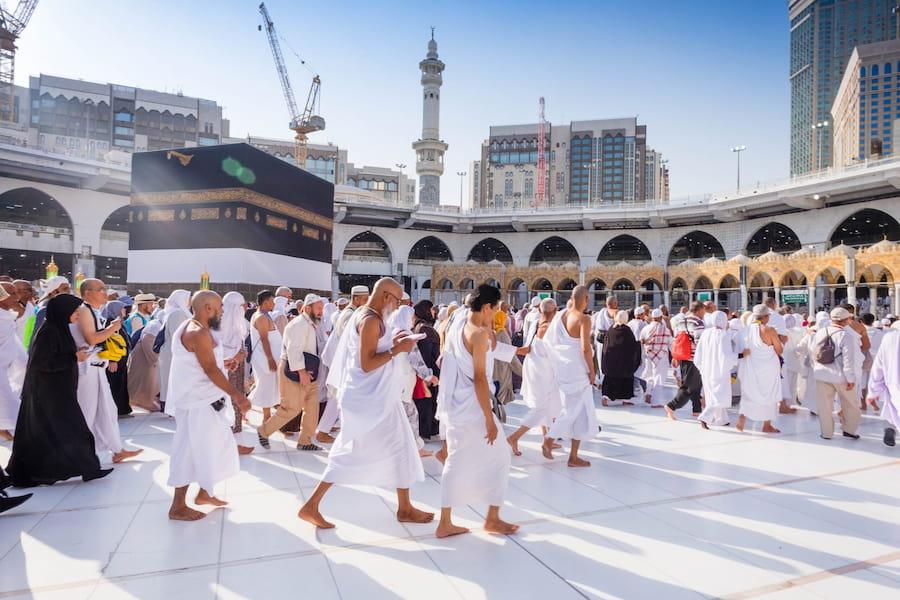Performing Umrah, a pilgrimage to Mecca in Saudi Arabia, is a significant and life-changing experience for many Muslims around the world. The pilgrimage involves several essential steps that the pilgrims must follow. Unlike the Hajj, which has specific dates, Umrah can be undertaken at any time of the year. The key steps in performing Umrah include the state of Ihram, performing Tawaf, performing Sa’i, shaving or shortening the hair, and finally, ending the state of Ihram. Each of these steps has its unique significance, and the entire journey is a spiritual one that requires deep devotion and faith.if you’re planning to get Umrah tickets 2024, this guide is for you.
Ihram
Preparation:
Before entering the state of Ihram, it’s important to trim facial hair, remove body hair, clip nails, and comb hair. A shower (Ghusl) or Wudu is performed to wash away dirt and purify oneself physically and spiritually.
Clothing:
Men change into two white, seamless pieces of cloth known as the Izar (lower garment) and the Rida (upper garment). Women can wear any form of clothing that covers the body and head, keeping hands and face exposed.
Shaving or Cutting Hair:
The final step involves men shaving their heads (Halq) or cutting their hair (Taqsir), while women cut a small portion of their hair, typically the length of a fingertip.
Making Niyyah (Intention):
At the Miqat, the designated boundary for entering Ihram, pilgrims make the Niyyah for Umrah, typically verbalizing their intention and reciting the Talbiyah prayer.
Personal Restrictions:
While in the state of Ihram, pilgrims must adhere to specific restrictions. Men cannot shave, cut their nails, or wear stitched clothing. Women must dress modestly and can wear stitched clothes but should not cover their face and hands. Both men and women are prohibited from using scents, engaging in marital relations, hunting animals, or harming plants.
Behavioral Conduct:
Pilgrims are encouraged to maintain a demeanor of humility, patience, and spirituality. They should avoid quarrels, obscene language, and all sinful acts during this sacred journey.
Tawaf
Importance of Wudu
Being in a state of Wudhu (ritual purity) is a prerequisite for performing Tawaf. If Wudu is nullified during Tawaf, it should be renewed before continuing.
Entry into Masjid al-Haram:
Pilgrims enter the mosque, preferably through the Bab al-Salam (the Gate of Peace), stepping in with their right foot first and reciting a supplication.
Circumambulation:
The Tawaf involves circling the Kaaba seven times in an anti-clockwise direction, starting and ending at the Hajr Aswad (Black Stone).
Rituals during Tawaf:
Men perform Raml (walking briskly) in the first three circuits and then walk normally for the remaining four. Throughout Tawaf, various supplications and prayers are recited.
Salah Al-Tawaf:
After completing the Tawaf, pilgrims perform two Rakats of Salah, preferably near Maqam Ibrahim. This prayer is a way of thanking Allah for the opportunity to perform Tawaf.
Drinking Zamzam Water
Pilgrims are encouraged to drink Zamzam water, available within Masjid Al-Haram, and make supplications. This act is not only a tradition but also a moment to seek blessings and make Dua.
Sa’i between Safa and Marwah
Starting from Safa:
The Sa’i begins at Safa Hill. Pilgrims ascend it, face the Kaaba, and make supplications to Allah. This practice is repeated when reaching Marwah.
Significance of Sa’i:
The Sa’i between Safa and Marwah symbolizes Hagar’s desperate search for water for her son, Ishmael, and is a reminder of the struggle and faith in Allah’s provision.
Completion of Sa’i:
The Sa’i comprises seven circuits between Safa and Marwa, ending at Marwah on the seventh circuit.
Towards the Black Stone:
While it is Sunnah to kiss the Hajar al-Aswad, pilgrims should avoid causing harm or inconvenience to others during the act. A symbolic gesture from a distance is acceptable if direct access is not possible.
Additional Observations
Equality and Humility:
The state of Ihram and the rituals of Umrah are designed to emphasize equality and humility among all pilgrims, erasing social and financial differences.
Spiritual Focus:
Throughout the journey, the focus is on spiritual purification and devotion, with various opportunities for prayers and supplications.
Post-Umrah:
After completing Umrah, it is a time for reflection, gratitude, and continuing the spiritual journey that started during the pilgrimage. Pilgrims often take this time to pray, read the Quran, and reflect on the experience.
Unity and Brotherhood:
The gathering of Muslims from all over the world for Umrah is a powerful symbol of Islamic brotherhood. It fosters a sense of community, unity, and global Islamic identity.
Conclusion
Umrah is an Islamic expedition to Mecca that is considered one of the most virtuous acts a Muslim can perform. It involves a set of physical and spiritual rituals that require careful preparation and devotion. The significance of each step of Umrah is deeply rooted in Islamic tradition. It is performed with the intention of seeking Allah’s blessings and forgiveness. The spiritual journey of Umrah is not only a means of fulfilling one’s religious obligations but also provides a chance for spiritual growth and self-reflection.

